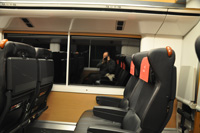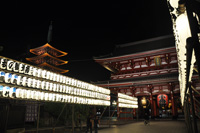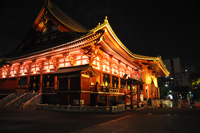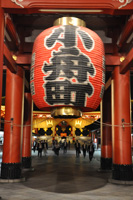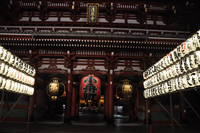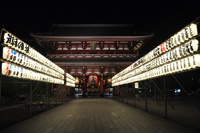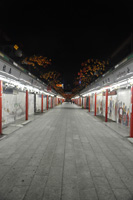 Tokyo, officially Tokyo Metropolis, is one of the 47 prefectures of Japan. It is located on the eastern side of the main island Honshū and includes the Izu Islands and Ogasawara Islands. Tokyo Metropolis was formed in 1943 from the merger of the former Tokyo Prefecture (Tokyo-fu) and the city of Tokyo. Tokyo is the capital of Japan, the center of the Greater Tokyo Area, and the largest metropolitan area of Japan. It is the seat of the Japanese government and the home of the Japanese Imperial Family.
Tokyo, officially Tokyo Metropolis, is one of the 47 prefectures of Japan. It is located on the eastern side of the main island Honshū and includes the Izu Islands and Ogasawara Islands. Tokyo Metropolis was formed in 1943 from the merger of the former Tokyo Prefecture (Tokyo-fu) and the city of Tokyo. Tokyo is the capital of Japan, the center of the Greater Tokyo Area, and the largest metropolitan area of Japan. It is the seat of the Japanese government and the home of the Japanese Imperial Family.
The Tokyo Metropolitan government administers the twenty-three special wards of Tokyo, each governed as a city, that cover the area that was the city of Tokyo as well as 39 municipalities in the western part of the prefecture and the two outlying island chains. The population of the special wards is over 8 million people, with the total population of the prefecture exceeding 13 million. The prefecture is part of the world's most populous metropolitan area with 35 to 39 million people (depending on definition) and the world's largest metropolitan economy with a GDP of US $1.479 trillion at purchasing power parity in 2008.
prefecture is part of the world's most populous metropolitan area with 35 to 39 million people (depending on definition) and the world's largest metropolitan economy with a GDP of US $1.479 trillion at purchasing power parity in 2008.
Tokyo was described by Saskia Sassen as one of the three "command centers" for the world economy, along with New York City and London. This city is considered an Alpha+ World City, listed by the GaWC's 2008 inventory and ranked third among global cities by Foreign Policy's 2010 Global Cities Index. In 2009 Tokyo was named the world's most expensive city for expatriate employees, according to the Mercer and Economist Intelligence Unit cost-of-living surveys and named the third Most Liveable City and the World's Most Livable Megalopolis by the magazine Monocle.
 My first impression of Tokyo, taking the train from the airport to the main terminal, is how orderly and kind people are. There were two young women on the train platform, a matched set, whose sole responsibility is to answer questions and bow to the train as it departs the station. The sprawl of Tokyo is beyond comparison. If New York City has 12 million people in its metro area and Tokyo has 35 million you might begin to get a sense. The airport is about 50 miles outside of town, and most of the city looks like a continuous miniature version of Times Square.
My first impression of Tokyo, taking the train from the airport to the main terminal, is how orderly and kind people are. There were two young women on the train platform, a matched set, whose sole responsibility is to answer questions and bow to the train as it departs the station. The sprawl of Tokyo is beyond comparison. If New York City has 12 million people in its metro area and Tokyo has 35 million you might begin to get a sense. The airport is about 50 miles outside of town, and most of the city looks like a continuous miniature version of Times Square.
The train from the airport was mostly empty, but the lack of people dramatically changed at Tokyo Station in the heart of the city. It took me about an hour to navigate to the correct route and then subway for the walk to the inn, or Ryokan, where I am staying in the Asakusa section of town. The Sensoji Temple is the neighborhood's most prominant feature. It is an ancient Buddhist temple, actually Tokyo's oldest. Formerly associated with the Tendai sect, it became independent after World War II. Adjacent to the temple is a Shinto shrine, the Asakusa Shrine.
 You have to imagine the crush of people on the subway as you look at these pictures from the mostly empty temple precincts. There's quite a contrast, as if this neighborhood keeps out everything that's frenetic in the city. At least at night. There's a bustling arcade during the day.
You have to imagine the crush of people on the subway as you look at these pictures from the mostly empty temple precincts. There's quite a contrast, as if this neighborhood keeps out everything that's frenetic in the city. At least at night. There's a bustling arcade during the day.
All the young professional men wear simple blacks suits. The older established men might distinguish themselves by wearing charcoal or a faint pinstripe. They all appear to wear black ties and are very uniform in their appearance. The other extreme I'm seeing are the young people who have punkish hair and look like anime characters. It is said that much business is conducted by men after hours, and that this usually involves heavy drinking. I am certainly more sensitive to these things since quitting drinking, but the trains reek of stale Sake and a high proportion of men on the streets were looking wobbly. It seems like the uniformity might be stifling and that other extremes creep out either in opposition to cultural norms or because of the desire for relief.
 I made my way through Tokyo Station at about 7pm and will be back there first thing in the morning. I'm hoping to beat rush hour as I hop on a Shinkansen, or bullet train, for Nagasaki in the morning. I will make it half the length of Japan in five hours.
I made my way through Tokyo Station at about 7pm and will be back there first thing in the morning. I'm hoping to beat rush hour as I hop on a Shinkansen, or bullet train, for Nagasaki in the morning. I will make it half the length of Japan in five hours.
The first moments at the Tokyo airport were disorienting as I had to track down the Japan Rail office and interact with people for the first time. Once I settled into the train I was totally comfortable, and was for the remainder of the trip.
